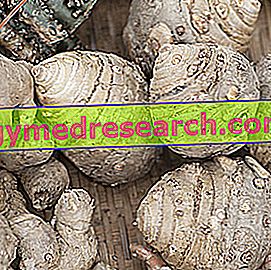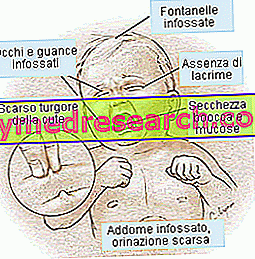
Scientific name
Pueraria mirifica L.
Family
Fabaceae
Origin
Thailand and Myanmar
Synonyms
White Kwao Krua
Used Parts
The part of the plant used as a drug consists of tuberous roots.
Chemical constituents
- Phytoestrogens, among which we find the miroestrol, deoxyiroestrol and isoflavones such as genistein, genistine, daidzein, daidzine, puerarin and cumestrol;
- Phytosterols such as beta-sitosterol, stigmasterol and campesterol.
Pueraria mirifica in Herbalist: Property of the White Kwao Krua
Pueraria mirifica is famous for its alleged rejuvenating properties, which appear to be effective in both men and women. However, thanks to its phytoestrogen content this plant seems to be especially useful in treating the symptoms of menopause .
Biological activity
Various properties are attributed to Pueraria mirifica, among which the rejuvenating ones stand out. In fact, the plant is credited with the ability to improve the firmness of the skin and breast (also increasing its size in both men and women), as well as the ability to promote and stimulate hair growth, also favoring the preservation of their color. In addition to this, the ability to alleviate the typical symptoms of menopause is attributed to Pueraria mirifica.
All the properties ascribed to Pueraria mirifica are attributable to the phytoestrogens contained in it. These molecules, in fact, possess a chemical structure similar to that of the estrogens present in our body and it is therefore possible that they manage to interact with endogenous estrogen receptors, stimulating them and thus exerting an estrogen-like action.
In this regard, several studies have been carried out on this plant, in order to determine its real therapeutic properties.
A study conducted on female rats in which a loss of bone mineral density was induced showed that daily administration of Pueraria mirifica for a period of sixteen weeks produced an increase in the same bone mineral density. In addition to this, this study has also shown that the administration of Pueraria mirifica can also be useful in preventing, not only in the treatment, this loss.
Another study conducted on menopausal monkeys has instead shown that the administration of Pueraria mirifica within the normal diet for a period of 16 months is able to decrease the loss of bone mineral density, significantly reducing also the risk of bone fractures, compared to the menopausal monkeys to which the plant has not been administered.
In light of the results obtained by these and other studies, Pueraria mirifica seems to be a valid and effective remedy to prevent loss of bone mineral density, hence osteoporosis, in menopausal women.
Another interesting study, carried out on healthy menopausal women between the ages of 45 and 60, has instead shown that daily administration of capsules containing Pueraria mirifica for a period of 24 weeks is able to produce a significant improvement in vaginal symptoms typical of the menopausal age. More in detail, Pueraria mirifica has been shown to exert an estrogenic type of effect on the vaginal tissue, obtaining results such as: reduction of vaginal dryness, reduction of dyspareunia and improvement of symptoms of vulvovaginal atrophy (a disorder that occurs in many menopausal women).
Therefore, encouraging results have emerged from the studies conducted so far, which outline Pueraria mirifica as a potential and effective remedy to be used to counteract the characteristic symptoms of menopause.
Pueraria mirifica in folk medicine and homeopathy
The roots of Pueraria mirifica have been used in Burmese and Thai folk medicine since ancient times. In fact, the plant - in association with other species of the genus Pueraria - came and is still used for the preparation of remedies with rejuvenating effects on the skin, teeth and eyes. In addition to these preparations, traditional medicine attributes the ability to improve male sexual performance.
Finally, according to popular medicine, Pueraria mirifica is also able to improve the quality of sleep and increase appetite, as well as to exert reinvigorating properties especially in relation to elderly and infirm people.
As far as homeopathic medicine is concerned, however, Pueraria mirifica currently has no use in this area.
Side effects
In some cases, following the use of Pueraria mirifica or its preparations, the occurrence of undesirable effects has been reported, such as: gastrointestinal disorders, sleep disturbances, vaginal discharge and breast pain.
Furthermore, a study carried out on animals has shown that taking high doses of Pueraria mirifica for long periods can negatively affect female reproductive activity.
For this reason, before taking Pueraria mirifica or its preparations, it is always good to ask for the preventive advice of your doctor.
Contraindications
The use of Pueraria mirifica is contraindicated in case of ascertained hypersensitivity towards one or more components.
Furthermore, given the high phytoestrogen content, the use of this plant during pregnancy and during lactation is generally not recommended. The use of estrogen-dependent tumors is also contraindicated.
Pharmacological Interactions
Although there is no definite information about possible drug interactions, given the phytoestrogen content in the plant, it is plausible that its intake may interfere with ongoing hormonal therapies.
Therefore, before taking preparations based on Pueraria mirifica it is necessary to ask the doctor's advice, informing him / her if they are already taking drugs of any kind, including other phytotherapeutic products, homeopathic medicines and medicines without a prescription.



